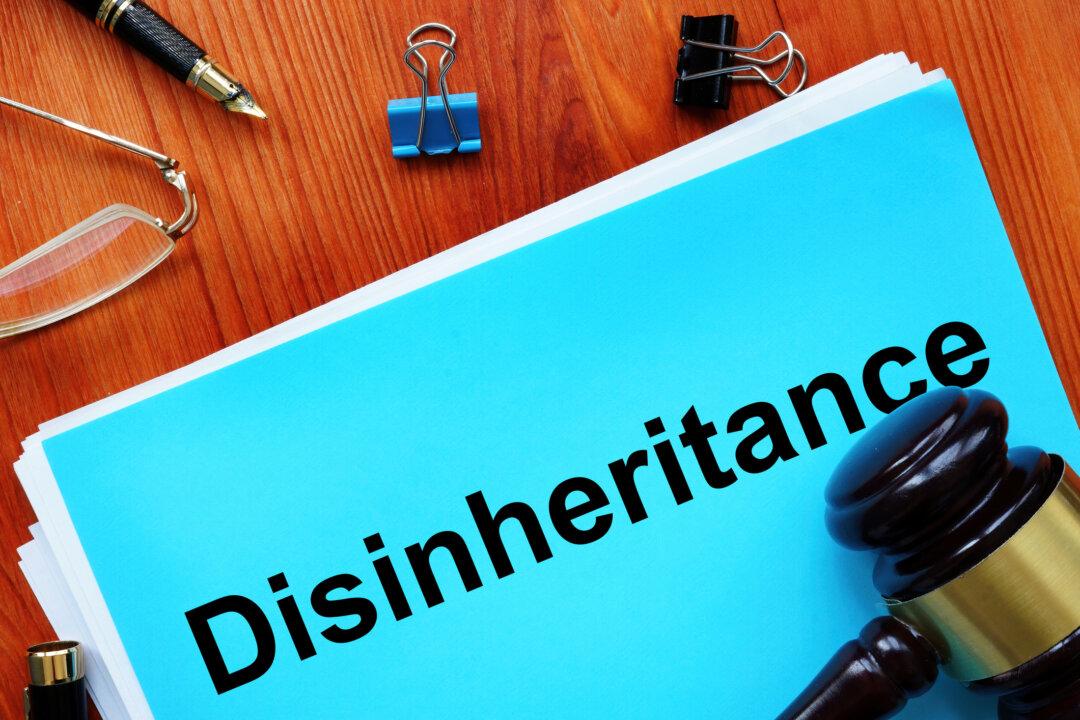What if you no longer want to include someone in your will? Well, how you choose to divide your estate is a personal decision and entirely up to you. There may come a time when you need to update and change the beneficiaries in your will because you no longer want to leave them a bequest or have them inherit anything from your estate.
To show your intention to disinherit someone, there has to be actual language in the written will stating that this person is disinherited. No reasons have to be given, but the language that is used has to be clear and easy enough to understand to prove that this is in fact your intention.
What Happens if You Die Without a Will
If you die without a valid will, you die intestate, and your state’s intestacy laws determine how your assets are distributed, typically to close relatives. Intestate succession laws would then dictate the order in which your assets are distributed to your heirs. The order of intestate succession begins with the decedent’s immediate family and extends out to distant relatives. Close relatives like spouses, children, grandchildren, parents, and siblings are typically prioritized.- Spouse, children, and grandchildren
- Parents and siblings
- Nieces and nephews
- Grandparents
- Aunts and uncles
- Cousins
Do You Have to Disinherit All Possible Heirs?
Fortunately, the law doesn’t require you to name each and every blood heir that could possibly inherit under intestate succession. Laura Cowan, estate planning attorney and founder of 2-Hour Lifestyle Lawyer, says you need to be clear and plan for contingencies or what she calls “the exploding Thanksgiving turkey.” This is a hypothetical example of what would happen to your estate if all of your heirs died simultaneously.She said you can make sure your money goes where you want it to by naming successors to stand in the place of your heirs, such as allowing your grandchildren to inherit in the place of your children if they should predecease you. This is called a per stirpes designation.
Per Stirpes, a Latin phrase meaning “per issue,” is a legal term that directs that each branch of the family inherits an equal share of the estate in accordance with the wishes of the testator (the person who created the will). As such, the beneficiary’s share of the estate will be passed on to the beneficiary’s heirs or descendants, even if the beneficiary should die before the testator.
People You Can’t Disinherit
There are some people that you can’t disinherit. You have a legal obligation to financially support your minor children and can’t disinherit them. As long as your estate has assets, state law would dictate that those assets be used to pay for the care and maintenance of any minor children.Reasons to Disinherit a Family Member
1) Divorce and Second Marriages
Why? A change in marital status should prompt you to look over your estate documents. It’s important to update your will after any divorce or remarriage; particularly if you have children from your prior relationship. Your new spouse will have statutory spousal inheritance rights, and depending on the state in which you are married, he or she might be entitled to at least half of your estate.If you have divorced, not updating your estate plan could mean your ex-spouse could still inherit directly from the will or as a designated beneficiary on one of your investment or retirement accounts.
2) Troubled Offspring
A parent can disinherit an adult child for just about any reason or even for no reason at all.Why? Sometimes, parents don’t have a good relationship with a child. That can be enough. However, one of the most common reasons for disinheriting a child is when the child is erratic or has some specific problems they are dealing with. These could include addictions to alcohol or drugs. In these circumstances, parents may realize that any money, assets, or property left to the child may contribute to or exacerbate the problem.
3) Child or Grandchild With Disabilities Who Is Receiving Benefits
Why? There are situations where cutting someone out of your will is the best decision for your heir. If you have a child or grandchild who has disabilities it may make sense to legally disinherit them. The reason for this is benign; the income from your estate may disqualify them from accessing any government assistance they would otherwise be entitled to receive.Most federal, state or local disability benefits include guidelines regarding the amount of money a recipient can earn or type of property a person can own without having it impact their benefits. If you were to leave an inheritance directly to your child or grandchild, they may lose those benefits.
That doesn’t mean you can’t still help them financially and make sure their needs are met. Cowan says the use of a special needs trust or supplemental needs trust would allow you to set aside money for their enjoyment and care without upending their eligibility for government programs and assistance.
The trust is irrevocable and is managed by a trustee for the benefit of your heir. By not owning the assets, the trust beneficiary preserves your child/grandchild’s eligibility for need-based government assistance programs. It is the best way to ensure your loved one’s financial needs will be met, even after you are no longer able to care for them.
4) Leaving Your Estate to Charity
Why? You’ve decided to leave all or the majority of your estate to a charitable cause. There can be a variety of reasons for this, including the ones listed above. Regardless of the reason, you need to be explicit about your wishes to leave your estate to a charity and not any of your heirs.If you have already designated other beneficiaries to receive any portion of your estate, you will need to disinherit them or revoke your existing will so you can designate the charity of your choice.
How? First you must determine your personal and financial goals in making a charitable gift to determine the best gifting strategy.
- Will or trust. If you want to leave the charity property, be very clear about the name of the charity and include its taxpayer identification number (TIN). This will avoid a mix-up as many charities can have similar names. TIN numbers are usually available on their website.
- Designate it as a beneficiary. A charity or nonprofit can be the beneficiary on your investment accounts, or life insurance policies.
- Donor advised fund (DAF). You can contribute cash, securities, real estate or other assets to a DAF. A huge plus to tax planning is that the contributions are considered a gift to charity for tax purposes.








